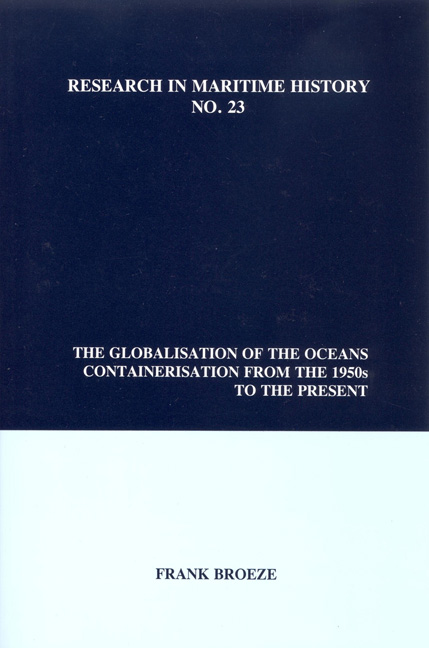Book contents
- Frontmatter
- Table of Contents
- List of Figures
- List of Tables
- Abbreviations
- Acknowledgments
- Preface
- Introduction
- Chapter 1 A Concept and its Realisation
- Chapter 2 The First Revolution
- Chapter 3 The 1970s: Conquering the World
- Chapter 4 The 1980s: Crisis and the Second Revolution
- Chapter 5 The 1990s: Globalisation
- Chapter 6 Ports, Port Systems and Liner Networks
- Chapter 7 Maritime Labour
- Chapter 8 Culture, the Environment and Recycling
- Conclusion
- Select Bibliography
Chapter 6 - Ports, Port Systems and Liner Networks
- Frontmatter
- Table of Contents
- List of Figures
- List of Tables
- Abbreviations
- Acknowledgments
- Preface
- Introduction
- Chapter 1 A Concept and its Realisation
- Chapter 2 The First Revolution
- Chapter 3 The 1970s: Conquering the World
- Chapter 4 The 1980s: Crisis and the Second Revolution
- Chapter 5 The 1990s: Globalisation
- Chapter 6 Ports, Port Systems and Liner Networks
- Chapter 7 Maritime Labour
- Chapter 8 Culture, the Environment and Recycling
- Conclusion
- Select Bibliography
Summary
We do not feel that just because a ship is bigger it is necessarily better. Not all ports can accommodate larger vessels.
The impact of containerisation on the world's ports and port systems was as revolutionary as its impact on shipping. Containerisation required shore facilities totally different in nature and appearance from those that had served for a century or more during the supremacy of the conventional passenger ship and cargo-liner. Intermodalism required further expansion and adaptation, not just in physical facilities but also in organisation and control. From the beginning container operators became directly involved in developing and managing terminals, a trend reinforced by the introduction of intermodalism. Although a number of ports remained public utilities that were not necessarily run on purely commercial criteria, others were exposed to the harsh world of the marketplace.
Port rivalry was nothing new, but ports now also had to be able to operate profitably - which, of course, did not mean that local or national authorities did not occasionally provide financial and other support. In their drive to cut costs, rationalise and become more efficient, many port authorities began to out-source functions and were corporatised and/or privatised. In its interaction with the big container companies and alliances, whose custom could make or break a harbour, the world's port industry became as globalised as its customers. During the 1990s, moreover, it became evident that running a port was a service function which could be exported through providing consultancy services to other port authorities, management contracts, joint ventures, and even direct investment abroad. A number of specialised port operators emerged which themselves built up networks of projects and investments around the world.
As individual ports were transformed, regional port systems followed suit. In the first stages of containerisation it appeared that conventional patterns might be duplicated, but the high capital intensity of the container industry at sea and ashore gave a fresh impetus to port rivalry, especially because terminals could, in principle, be built at almost any location. The rise of Felixstowe and Southampton in the early 1970s in England as container ports was a signal to all.
Since shipping companies aimed at limiting the number of ports of call, a process of concentration took place, with stronger container ports obtaining regional hegemony and subordinating others.
- Type
- Chapter
- Information
- The Globalisation of the OceansContainerisation from the 1950s to the Present, pp. 165 - 212Publisher: Liverpool University PressPrint publication year: 2000



